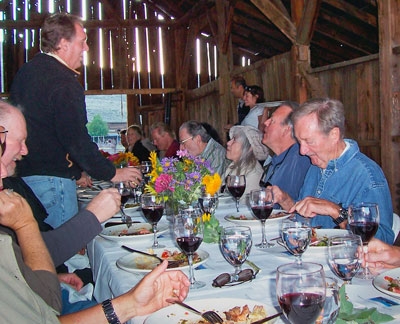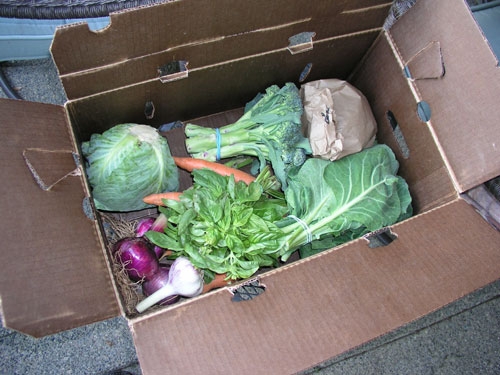Posts Tagged: Shermain Hardesty
Media gets UC input for stories on unconventional farming
Reporters sought UC Cooperative Extension expertise for recent articles about unusual farming efforts in two parts of California.
Fresno Bee reporter Robert Rodriguez covered the story of sisters in their early 20s who have settled on their dad's Laton alfalfa farm after he suffered complications from a black widow bite. The young women purchased chickens on a whim and began producing specialty eggs under the brand name "Just Got Laid."
Rodriguez spoke to Shermain Hardesty, UCCE specialist in the Department of Agriculture and Resource Economics at UC Davis, about trends in cottage farming.
"The timing is right for operators who can make a connection with consumers," Hardesty said. "People will support that."
Sacramento Bee reporter Edward Ortiz wrote about a return to dry-land farming in the Central Valley, with examples of farmers opting out of irrigation in producing particularly tasty apricots, wine grapes and tomatoes.
UC experts, however, commented on the difficulties associated with dry-land production in the valley.
"Dry farming would be a hard life because you're at the whim of the rains," said Jay Lund, director of the Center for Watershed Sciences at UC Davis. "It would have to be a fairly small-scale farm, and in some cases, it would be a good road to poverty."
For the Modesto Bee version of the story, Roger Duncan, UC Cooperative Extension advisor in Stanislaus County, told the reporter dry-land farming doesn't appear to be catching on locally.
Duncan said wine grape growers might withhold irrigation early in the growing season to control leaf growth and improve fruit quality, but water is still needed later on. He noted that the valley in the 19th century was widely planted with wheat that relied on rainfall. The boom ended when irrigation allowed diverse fruits, vegetables and other crops to be grown.
Growers can find strength - and profit - in numbers
Multi-farm community-supported agriculture programs, cooperatives and pools under a common label are some ways small- to medium-sized operations can reach new customers interested in local produce, wrote Renee Stern in The Grower.
Together, growers can offer enough volume or range of crops to attract retailers, foodservice outlets or institutions that might be out of reach for each individual farm.
Stern included comments from a wide variety of experts in her article, including marketing professionals, small-scale farmers, a co-op manager and Shermain Hardesty, UC Cooperative Extension specialist at UC Davis with expertise in agricultural economics.
She told the reporter that someone — ideally one of the producers — needs to take charge of the collaborative marketing program, but finding someone with the time, aptitude and inclination may mean hiring a manager.
Do farm subsidies cause obesity?
Christopher Shea, Wall Street Journal
The link between agricultural subsidies and obesity is highly tenuous, according to a UC study that analyzed the effects of price supports on diet. The study, authored by Bradley Rickard, Abigail Okrent and Julian Alston, says if all subsidies were magically erased — including trade barriers — the typical American adult would actually respond by eating about 3,000 to 3,900 additional calories a year.
Alston is an agricultural economics professor at UC Davis, Richard is with Cornell, Okrent is a Ph.D. candidate at UC Davis.
Agritourism in agriculture's heartland
Thirty percent of the farmers offering agritourism events supplemented their regular farm income by $50,000 or more in 2008, according to a study by the UC small farm program that was covered on the front page of today's Fresno Bee. Nearly two-thirds of California agritourism operators planned to expand or diversify over the next five years.
"There is no question that there is a lot of potential for growth, and we are seeing it happen," the story quoted Shermain Hardesty, small farm program director and a co-author of the report.
In the article, reporter Robert Rodriguez described several Valley agritourism destinations:
- Visitors can stay the night on the 95-acre tree Dinuba farm of Nori and Mike Taylor.
- Farmer John Olivas lets people pick their own fruit and operates a fruit stand on his three-acre berry farm in Hanford.
- Fresno farmer Mike Smith will allow people to pick their own flowers, lavender and produce on his 40-acre organic farm. In the fall, he will operate a pumpkin patch for the public and school tours.
"We know from all the consumer trends that people are willing to pay for an authentic experience and for specialty foods," said Ellie Rilla, community development adviser for UC Cooperative Extension in Marin County and co-author of the study. "And agritourism provides that."
The research article, California agritourism operations and their economic potential are growing, was published in the current issue of California Agriculture journal.

Bringing in visitors for a dinner in a barn is one form of agritourism.
UC helps community develop local food systems
The movement in Lake County to encourage local citizens to consume locally produced agricultural products got a boost last month when a diversity of experts brought in ideas that have worked elsewhere in the state, according to a story in Lake County News.
Food systems analyst Gail Feenstra of the UC Sustainable Agriculture Research and Education Program explained how schools in Davis, Calif., increased students' fruit and vegetable consumption by tying the salad bar selections to school garden lessons.
To help fund the program, the coordinators turned food scraps into compost for the gardens. By reducing the amount of garbage, they saved the district $60,000 – enough to fund their positions and subsidize the gardens.
City of Davis voters also passed a parcel tax to help subsidize the program, finding it worthwhile to ensure all students were served nutritious lunches made from locally grown foods, the article said.
Shermain Hardesty, extension specialist for agricultural and resource economics at UC Davis, presented information at the gathering on establishing local food systems.
"Building things from scratch, by yourself, costs money. Look for partnerships using existing resources," Hardesty was quoted in the article.
She led an interactive exercise asking participants what was missing in Lake County's local food system, with grains, meat and dairy the most often mentioned. The group then discussed what infrastructure was needed to create local industries that would meet these needs.
Other projects supporting local agriculture addressed at the workshop were:
- The Lake County Community Co-Op, an online distribution system that enables members to order certified organic products directly from local producers
- “Lake County Grown,” sponsored by Lake County Farm Bureau, for online ordering of local produce
- The LAVA Center, which buys overages and blemished produce from farmers and adds value by turning it into another product, such as sauces or chutneys.
Sacramento farms sell direct at high rate
Fourteen percent of Sacramento-area farms market directly to consumers, compared to just nine percent of farmers nationally, according to research by Shermain Hardesty, UC Davis Cooperative Extension economist. The study was publicized in a UC Davis news release, and picked in the Sacramento Business Journal.
Hardesty found that farms in the Sacramento region averaged $19,518 in annual income in direct sales - at such outlets as farmers markets and roadside stands. California farms' direct sales income ranged from an average of $6,924 in Placer County to $66,568 in Yolo County.
“We were especially interested to find that, even after deducting the added costs of transportation, distribution and selling at the farmers market or other point of sale, the farmers are still able to net a greater share of retail prices in local food supply chains than they would had they used conventional marketing chains,” the news release quoted Hardesty.For example, mixed greens growers in Monterey County receive on average 79 cents per pound by marketing through conventional channels. One Yolo County grower netted seven times that price at a farmers market.
The full report, “Comparing the Structure, Size, and Performance of Local and Mainstream Food Supply Chains,” is available from USDA.

Yolo County farmer sells direct to consumer.



